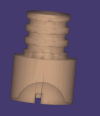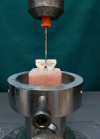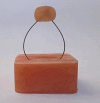Mechanical properties of combined packable and high-filled flowable composite used for the fixed retainer: an in vitro study
- PMID: 38858745
- PMCID: PMC11165839
- DOI: 10.1186/s12903-024-04437-w
Mechanical properties of combined packable and high-filled flowable composite used for the fixed retainer: an in vitro study
Abstract
Background: Clinicians often utilize both flowable and packable composites concurrently in bonding fixed retainers. Thus, this study aimed to assess the synergistic effect of these composites in the bonding process.
Methods: This in vitro study divided specimens into three groups: flowable composite (nano-hybrid, Tetric N-Flow, Ivoclar Vivadent), packable composite (nano-hybrid, Tetric N-ceram, Ivoclar Vivadent), and combined use of flowable and packable composite. Shear bond strength (SBS), adhesive remnant index (ARI), and wire pull-out resistance were compared among the groups. Statistical analyses were conducted using ANOVA and Tukey tests to compare study groups. Additionally, Chi-square and Kruskal-Wallis tests were employed to analyze the ARI index among the groups.
Results: ANOVA results indicated no statistically significant differences among test groups (P = 0.129) regarding SBS. However, a significant difference existed between flowable and packable composite groups (P = 0.01) regarding ARI scores. Among the study groups, flowable composite exhibited the highest frequencies of ARI scores of 1 and 2, whereas packable composite showed the highest frequency of ARI scores of 0. The combined group had higher frequencies of ARI scores of 0 and 1 compared to the flowable composite. The wire pull-out test revealed that the combined application of flowable and packable composite resulted in significantly lower detachments compared to the packable composite alone (P = 0.008). However, no significant differences were observed in the comparisons between the flowable-packable (P = 0.522) and combined-flowable (P = 0.128) groups.
Conclusion: The combined use of flowable and packable composites for fixed retainers demonstrated adequate shear bond strength and ideal ARI scores, suggesting it as a suitable adhesive system for bonding orthodontic fixed retainers.
Keywords: Adhesive; Biomedical and dental material; Composite; Fixed retainer.
© 2024. The Author(s).
Conflict of interest statement
The authors declare no competing interests.
Figures







Similar articles
-
Impact of bonding protocols and physical-mechanical properties of composite on durability and failure rate of fixed orthodontic retainers: a systematic review of laboratory studies.BMC Oral Health. 2025 Jul 26;25(1):1255. doi: 10.1186/s12903-025-06635-6. BMC Oral Health. 2025. PMID: 40713668 Free PMC article.
-
Adhesive properties of bonded orthodontic retainers to enamel: stainless steel wire vs fiber-reinforced composites.J Adhes Dent. 2009 Oct;11(5):381-90. J Adhes Dent. 2009. PMID: 19841765 Clinical Trial.
-
Different Wire Surface Treatments on Adhesion Efficacy of Orthodontic Fixed Retainer: An In Vitro Study.J Contemp Dent Pract. 2024 Jul 1;25(7):677-683. doi: 10.5005/jp-journals-10024-3726. J Contemp Dent Pract. 2024. PMID: 39533939
-
Are the flowable composites suitable for orthodontic bracket bonding?Angle Orthod. 2004 Oct;74(5):697-702. doi: 10.1043/0003-3219(2004)074<0697:ATFCSF>2.0.CO;2. Angle Orthod. 2004. PMID: 15529507
-
Shear bond strength of a new low-shrinkage flowable composite for orthodontic bracket bonding.J Dent Child (Chic). 2014 May-Aug;81(2):63-6. J Dent Child (Chic). 2014. PMID: 25198947
Cited by
-
Impact of bonding protocols and physical-mechanical properties of composite on durability and failure rate of fixed orthodontic retainers: a systematic review of laboratory studies.BMC Oral Health. 2025 Jul 26;25(1):1255. doi: 10.1186/s12903-025-06635-6. BMC Oral Health. 2025. PMID: 40713668 Free PMC article.
References
-
- Egli F, Bovali E, Kiliaridis S, Cornelis MA. Indirect vs direct bonding of mandibular fixed retainers in orthodontic patients: comparison of retainer failures and posttreatment stability. A 2-year follow-up of a single-center randomized controlled trial. Am J Orthod Dentofac Orthop. 2017;151(1):15–27. doi: 10.1016/j.ajodo.2016.09.009. - DOI - PubMed
MeSH terms
Substances
LinkOut - more resources
Full Text Sources

